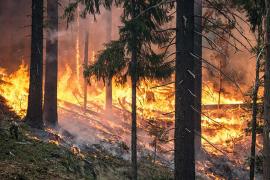In December of 2018, CBS News broadcast a report detailing more than 500 allegations of child sexual abuse at summer camps over a period of more than 50 years (CBS News, 2018). The numbers are certainly shocking. Yet for those of us who investigate child sexual abuse and advocate for solutions to prevent it, they are not actually that surprising.
For years, experts reported that one in four children would be sexually abused by the time they reach 18. That number has recently been revised to one in 10 (Darkness to Light, 2015). Yet whatever the numbers, the stark reality is the same — if your camp has welcomed hundreds of campers each year, and if it’s been doing so for any length of time at all, then it is absolutely certain that you will have cared for survivors of abuse. Disturbingly, it would be surprising to learn that some form of abuse had not happened in your programs at some point in your camp’s history.
The good news is there is now a tremendous opportunity to make changes — changes that have been a very long time coming.
The Rise of #MeToo
Whether it’s Larry Nassar and USA Gymnastics, Boy Scouts of America, or the Catholic Church, it has become impossible to ignore the ongoing drumbeat of revelations around sexual misconduct and abuse. The obvious lesson of these stories is that abuse at all types of youth-serving community organizations has been much more widespread than previously thought. There is, however, another important and more encouraging takeaway: Society is finally taking notice and abusers (and their enablers) are going to be held to account to a greater degree than they ever have been before. The case of Jeffrey Epstein is a nearperfect example of this societal shift. In 2008, despite ample evidence of other crimes, he received only 18 months in prison on one prostitutionrelated account. As part of his plea deal, he was allowed up to 12 hours of daily work release too — a condition he allegedly used to commit further acts of sex trafficking while serving his sentence (Ovalle, 2019). Fast-forward to 2019, and Epstein was facing very similar charges. This time, however, he was looking at 40 years in prison, plus the loss of his $77 million mansion in Manhattan.
Epstein’s later suicide doubtless leaves many survivors feeling robbed of justice. Yet the societal backlash that brought him down is a movement that is long overdue. It’s time for all of us to step up and say “Enough.”
Society Has Had Enough
Camps have already been doing a lot when it comes to abuse prevention. From criminal background checks to “no alone time” policies, abuse prevention measures have been steadily improving over time. Steady improvement, however, is not enough. Society’s expectations of us have changed.
Take just one recent example: Two campers of opposite sexes were sitting next to each other on a bus. Staff noticed that they were touching each other inappropriately under a towel and immediately separated the two children. They reported the incident to camp supervisors who notified parents and took appropriate action to address the behavior. In other words, it appears they did exactly what they were expected to do in responding to an incident of peer-to-peer abuse. Yet the camp itself is still being sued by one of the children’s parents, and cases like this are increasingly becoming the norm.
Clearly, we need to develop cultures and environments where any inappropriate behavior, red flags, or rule breaking — both by campers and staff — is immediately detected and addressed before it can develop into abuse. Society will not be satisfied with anything less.
A Tsunami of Allegations Is Coming
Societal attitudes aren’t the only things that are changing. The legal environment is changing too.
Most recently, New York State enacted the Child Victims Act — a measure that extends the age at which a survivor can come forward and sue their abuser from 23 to 55, and which also includes a one-year lookback period for survivors who had previously missed the opportunity to sue. Almost immediately, a tsunami of more than 400 lawsuits was filed, and experts expect many more to follow (Anthony, 2019). Similar reforms are being worked on in 29 states.
| To get an up-to-date understanding of any Statute of Limitation reform legislation either enacted or being worked on in a specific district, camps can reach out to us at The Redwoods Group, check the Child USA website, or reach out to their local counsel. |
With each new reform will come a wave of historical allegations that are likely to hit all youth-serving movements across the country. Camps will need to be prepared to respond. The good news is, responding to an adult survivor of child sexual abuse involves much the same skill set and knowledge as responding to a child survivor.
Specifically, an adult survivor of abuse is going to want to hear four things:
- I believe you.
- It’s not your fault.
- I will do all I can to help you heal.
- We now have policies and practices in place that prevent this from happening at our camp.
This fourth point is worth emphasizing because it is additional to how we advise responding to child victims, and because it provides an opportunity to create a meaningful relationship with the survivor that’s based on trust and shared goals.
Once a camp has identified its protocol for responding to adult survivors, it’s important to make sure that the camp’s entire staff, board, legal counsel, and volunteer base is on board with this approach, ideally before it becomes necessary to enact it. And the camp is going to need to make sure they have as much information as they can possibly gather, dating back as far as they can, about their historical insurance coverage to make sure their mission is protected when survivors do come forward. And just as important is that survivors have access to the resources they need to help them heal.
Ultimately, we find ourselves in extremely challenging, even nerve-wracking times. For those of us who believe passionately in the power of the camp experience, it can be hard to think about the harm that’s been done to young people while away at camp. Yet, the fact is, harm has happened — and it has happened on a more frequent basis than many of us may have previously recognized. Understanding this and adjusting how we operate is not only our duty as a youth-serving movement, but it is also a profound opportunity to live our values and finally create a society where abuse has no place to flourish.
Creating Multiple Layers of Protection
For years, aquatic safety experts have emphasized the idea of multiple layers of protection — from lifeguarding protocols to community swimming lessons — as the only way to effectively and consistently prevent drownings. Abuse prevention is no different.
- Educate and Protect: Develop clear protocols and a comprehensive annual training program that involves all staff counselors and volunteers, and supplement that training with regular check-ins and informal exercises to keep the learning fresh. Ask all counselors and staff to sign a code of conduct. Follow through with consistent supervision and enforcement of rules.
- Communicate and Empower: Reach out to all camp families and stakeholders. Inform them of your positions and policies and ask them to hold you accountable. Point them to resources they can use to help educate the community and provide them with multiple channels of communication to report any potential concerns.
- Prepare to Respond: Prepare yourself, your staff, and your boards to respond to historical allegations in a manner that’s consistent with your values and puts the well-being of survivors at the heart of your decision-making. It’s also important to work with your broker and your insurance carrier(s) to ascertain your insurance history dating back as far as you possibly can. Consider retaining the services of Insurance Archaeology Group (iagltd.com) or a similar entity with specific expertise in mapping your historical insurance assets.
References
- Anthony, A. (2019, January 28). New York passes Child Victims Act, allowing child sex abuse survivors to sue their abusers. CNN. Retrieved from cnn.com/2019/01/28/us/new-york-child-victims-act/index.html
- CBS News. (2018, December 10). Hundreds of sexual abuse cases reported at children’s camps across U.S. Retrieved from cbsnews.com/news/hundreds-sexual-abuse-cases-childrens-camps-reported-across-us-cbs-this-morning/
- Darkness to Light. (2015). Child sexual abuse statistics: The magnitude of the problem. Retrieved from d2l.org/wp-content/uploads/2017/01/Statistics_1_Magnitude.pdf
- Ovalle, D. (2019, August 20). Jeffrey Epstein lawsuits offer sordid details, including sex while on work release. Miami Herald. Retrieved from miamiherald.com/news/state/florida/article234189557.html
Kevin A. Trapani is cofounder and CEO of The Redwoods Group, a Crum & Forster Company. He can be reached at 919-931-6316.



